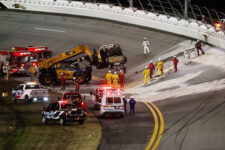[media-credit name=”Credit: Jonathan Ferrey/Getty Images for NASCAR” align=”alignright” width=”225″] [/media-credit]NASCAR officially opened its 2012 racing season by presenting their annual Speedweeks. From the annual Budweiser Shootout to the Daytona 500, NASCAR presented its fans six races featuring its three national touring divisions: the Sprint Cup Series, the Nationwide Series and the Camping World Truck Series.
[/media-credit]NASCAR officially opened its 2012 racing season by presenting their annual Speedweeks. From the annual Budweiser Shootout to the Daytona 500, NASCAR presented its fans six races featuring its three national touring divisions: the Sprint Cup Series, the Nationwide Series and the Camping World Truck Series.
True to the nature of the racing, at this massive 2.5 mile steeply banked oval, the race vehicles ran in tight packs, perilously close to each other at all times, and the result was a lot of accidents. According to reports the three national series had a total of 122 entries. From that number at least 90 of them sustained crash damage ranging from light to moderate and, in some cases, completely totaled.
Some of these accidents involved extremely hard hits. The type of crash that instantly made us express concern for the drivers inside of the vehicles. The following is an example of some of the harder hits during Speedweeks:
During the final moments of the Budweiser Shootout, Jeff Gordon was collected in a multi-car incident. His Chevrolet barrel rolled and then came to a rest on its roof.
During that same event, there was a multi-car crash that sent Kevin Harvick into the wall. The hit was so hard the car burst into flames.
During the final lap of the first Gatorade Duel qualifying race, Danica Patrick was the victim of an errant bump draft that led to an extremely hard hit into the retaining wall and a totaled race car.
During the NextEra Energy Resources 250-Camping World Truck Series race, Miguel Paludo spun out and hit the inside retaining wall so hard that his truck flew in the air and did a 360 degree circle while all four tires were still off of the track surface.
During that same event, in the midst of a green-white-checker finish, Joey Coulter’s truck sustained major damage after he went up in the air, turned a complete mid-air somersault and then hit the safety catch fence that protects the spectators.
During the Drive4copd 300-Nationwide Series race there was a multi-car, Daytona “big one,” that saw a whopping 19 cars sustain major crash damage. This incident was followed by a red flag so the track maintenance crew could remove a front splitter from one of the cars that was literally embedded in the retaining wall.
The very first completed lap of the Daytona 500 was followed by another errant bump draft that saw Jimmie Johnson’s Chevrolet bounce off the wall and then slide into the path of oncoming race traffic. Johnson was hit hard, in the area of the driver’s door, by David Ragan who simply had to place to go.
The most frightening moment of all, during the Daytona 500, was also one of the most bizarre accidents we’ve seen in quite a few years. With the field already under caution, Juan Pablo Montoya came to pit road due to a bad vibration in his Chevrolet. Montoya returned to the track and accelerated in an effort to rejoin the field. He later reported that he heard a loud noise as if something had broken in the rear of the car. That’s when the car went into a slide and stuck a jet dryer who was cleaning the track at the time. Montoya’s car caught fire and was totally demolished. The jet dryer’s fuel tank was ruptured and 200 gallons of jet fuel burst into flame. This was followed by a lengthy, two hours plus, red flag period to allow the track crews to clean and repair the racing surface.
What do all of these major incidents have in common? Every one of the drivers involved in them walked away uninjured.
That fact is an extreme testimony to the safety innovations NASCAR has implemented over the past several years. When they introduced the C.O.T, (Car Of Tomorrow), a few years ago, carefully designed improvements to enhance driver safety was their main motivation.
There was also the implementation of some mandatory safety innovations such as the energy absorbing soft retaining walls, or SAFER Barriers, as well as the mandatory use of driver head and neck restraints along with improvements in driver seats and the seat belts attached to them. The truth be known, a NASCAR driver is a lot safer in a car turning 200 MPH around Daytona than we the fans are in our personal vehicles doing 65 MPH on a freeway.
In the case of the multiple crashes, during the Daytona Speedweeks, we also need to express our appreciation to the speedway’s emergency teams who made extremely quick work of arriving at the accident scene to check the status and the needs of the drivers.
Also, appreciation needs to be expressed to the speedway’s maintenance crews who were extremely busy during Speedweeks. During the course of those six races they found themselves repairing panels in the safety barriers, shoring up a damaged catch fence as well as extracting the aforementioned splitter from a crash wall.
But the major contribution made by the maintenance team came in the aftermath of the jet dryer fire. The fact that they were able to clean a major portion of turn three, and then patch large ruts in the track surface, in approximately two hours is just amazing. The fact that we were able to watch the conclusion of the Daytona 500 is in direct proportion to their hard work.









